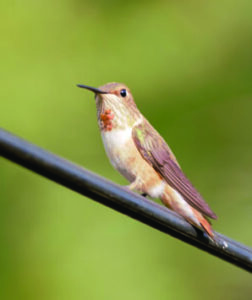By Debbie Roland and
Emmy Ulmschneider
Master Gardeners
Native plants. Perhaps the most important question is why go to the trouble? There are many answers to this question, but these are the “heart reasons.” Reasons that we cannot touch but affect our outlook on life.
Our food, our clean water, the air we breathe, the soil beneath our feet, even our climate are all a function of the ecosystems that support us. It is no surprise that during these pandemic times, people found escape and solace in getting outside and reconnecting with nature. But what if all you had to do was to step outside your back door to be awed and amazed?
There is no time like the fall, the time of epic southward migrations, to become aware of the wonders in a native yard. This morning, my heart was lightened by watching a half dozen hummers refueling around me before continuing south.

Texas has roughly eighteen documented species of hummingbirds. But in Midland, we are most commonly apt to notice our summer resident Black-chinned and the migrating Rufous Hummingbirds.
So, what does it take to attract hummers to your yard? Food, water, and shelter. Although hummers will nectar on a variety of plants, red, tubular flowers are a draw and we have covered some of these high value native plants previously: Autumn sage, Turk’s cap, cross-vine, and red yucca. In addition, Salvia darcyii and flame acanthus are favorites. If you see a hummer vigorously flying around a plant, it is probably “hawking” on a swarm of flying insects or picking insects off a bloom. Hummers will hawk around sunflowers, Gregg’s blue mist, and rosemary. Start small, all you need are pots of these plants on a patio, along a walkway, or scattered throughout your yard.
If you are working towards a hummingbird garden, know that a garden should be open enough to fly in and surrounded by trees or shrubs to perch and shelter in. Remember to include plants with different bloom times so that there is always nectar.
A water source and a supplemental feeder fill out the list of a well-stocked hummingbird garden. Hummers will use any water source if they are shallow enough.
Shelter is often overlooked in our yards. Hummers like to nest about 5-15 feet off the ground so be sure you leave them places for shelter when you are doing your annual pruning.
So, if you are interested in making your yard come alive with these tiny, jeweled wonders, think red, think natives and think habitat!
For more information, call the AgriLife office at 498-4071 in Odessa or at 686-4700 in Midland or visit aggie-horticulture.tamu.edu or westtexasgardening.org.




